New ICH Guidelines Address Industry Inefficiency
Applied Clinical Trials
In this article, Crissy MacDonald reviews the key changes in ICH E6 (R2), discuss the challenges organizations are facing, and present actionable recommendations for organizations to implement now.

Although the pharmaceutical industry has always incorporated risk-based processes, the ICH E6 (R2) addendum now mandates that clinical trial operations also include risk-based approaches. Based on the latest research, and The Avoca Group’s experience helping companies implement remediations, a fundamental shift in mindset is necessary in order for the industry to properly address the required changes. This article is a review of the key changes in ICH E6 (R2), discussion of the challenges organizations are facing, and presentation of actionable recommendations for organizations to implement now.
Key changes to ICH E6 (R2)
With the evolution of clinical trials and the supporting technology and processes, there are new opportunities to increase efficiency and focus on relevant activities. Recognizing the importance of this, the International Council for Harmonization of Technical Requirements for Pharmaceuticals for Human Use (ICH) released a revision to its guidelines to: “encourage implementation of improved and more efficient approaches to clinical trial design, conduct, oversight, recording, and reporting while continuing to ensure human subject protection and reliability of trial results.”
In addition, to support innovative processes, the standards for essential documents have been updated to include process and procedural documentation outside the standard definition of required documents.
Risk-based strategies
The strong risk-based component to the new regulations recommends oversight commensurate with the important risks. It is almost impossible to monitor the nearly one million data points collected in an average Phase III trial. Therefore, identifying the important data points-for subject safety and reliability of the results-can help prioritize the data monitoring strategy.
To have successful risk-based strategies, the organization must also have an appropriate quality management system (QMS). This system should be responsive to the trial needs, include documentation of the rationale for the chosen strategy, and have clearly defined roles and responsibilities.
Risk planning
With the updated regulations, the sponsor and investigator(s) retain accountability for trial quality, necessitating effective oversight and a good understanding of risk management. All parties participating in the operation of the clinical program must agree and understand the expectations for each role-clear documentation of this is required.
When outsourcing study management, the sponsor organization must maintain a key role in pre-study risk planning. Although the CRO can be responsible for risk planning, the CRO needs to obtain agreement from the sponsor on the critical factors for quality, defined thresholds, and mitigation plans.
Quality management
Section 5.0 in ICH E6 (R2) outlines the quality management recommendations, focusing on subject protection and the reliability of the trial results. Information essential to decision-making should be collected.
Quality by design (QbD) practices minimize risk through proactive planning-using current knowledge as well as historical data about the organization and investigational product. The planning process should identify which risk signals can be detected early and outline the associated mitigations (including an investigation of the root cause). Then, findings from any corrective actions, preventative actions, and mitigation should be built into the process. Finally, the outcomes of this initial planning phase can be used to make quality-focused decisions.
Electronic systems
To ensure quality data, validation and quality control are required using qualified users and SOPs that cover system setup, installation, and use.
Any electronic data handling and/or remote electronic data systems must be validated, meaning the system conforms to the established requirements for completeness, accuracy, reliability, and consistent intended performance. Sponsors must determine and document that specific requirements of the computer system can be consistently fulfilled from design until system decommissioning/transition to a new system.
The validation approach should be based on a risk assessment that considers the intended use and the potential to affect the protection of subjects and reliability of trial results.

Serious breaches
Regulatory authorities want to know when something has gone wrong, and it is best to be up front when non-compliance is detected. Therefore, make sure to inform regulators when non-compliance is a serious breach of protocol or good clinical practice (GCP) guidelines.
Essential records
According to the updated guidance, “Essential documents are those documents which individually and collectively permit evaluation of the conduct of a trial and the quality of the data produced. These documents serve to demonstrate the compliance of the investigator, sponsor, and monitor with the standards of GCP and with all applicable regulatory requirements.”
Therefore, it is important to document what you’re doing and how you perform your risk management processes, including the following components: monitoring plan, integrated quality management plan, quality management plan, and the outcome of and actions taken because of centralized/statistical monitoring.
All procedures and processes within clinical trial execution should be documented in the trial master file (TMF) and undergo periodic review. ALCOA-C (Attributable, Legible, Contemporaneous, Original, Accurate, Complete) provides some crucial concepts regarding source documentation and helps ensure confidentiality, credibility, accuracy, and validation.
Key challenges with implementing ICH E6 (R2)
ICH E6 was updated because of the increased use of technology in clinical trials, making real-time feedback of
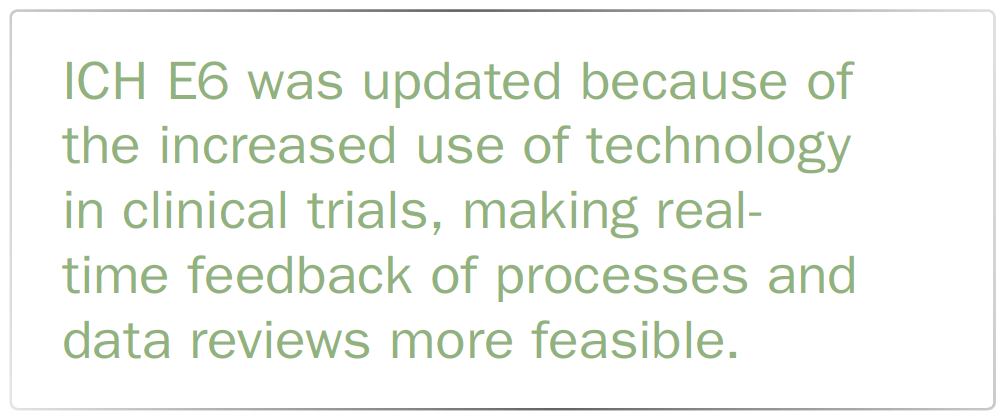
processes and data reviews more feasible. Regulators now require the use of safe technologies to more efficiently and effectively design and conduct the clinical trial. However, implementing these new requirements can seem daunting-the use of more proactive approaches represents a shift from typical industry operation.
Based on a survey The Avoca Group conducted with 80 respondents from the attendees of ExL’s 7th Clinical Quality Oversight Forum in 2017, the reported challenges with moving toward ICH E6 (R2) fit into three buckets: change management, oversight, and data-driven decisions.
Change management
Organizational change management is one of the primary challenges with the new regulations. Organizations are a complex mix of processes, people, and management. Operational staff often recognize the impact of quality on the day-to-day level, while top-level executives often view the big picture, making it difficult to get leadership buy-in. A one million-dollar question in the industry remains: the comparison of the cost of proactive risk mitigation vs. the cost if the risk actually becomes an issue-this ultimately affects the bottom line.
Quality ownership is also changing; ICH E6 (R2) mandates that everyone is part of the quality process and process improvements throughout the entire clinical trial. Therefore, quality is no longer just the quality assurance (QA) team’s concern. Although changes to internal processes are required for compliance, the resourcing required to update these processes often competes with current priorities and daily tasks.
Through my interactions with companies, I’ve found that employees “not knowing” if the company is currently ICH E6 (R2) compliant represents a lack of understanding throughout the entire organization of its importance, its meaning, and the difference from current operations. We need to start recognizing that this isn’t just about quality-it is about creating more efficient, risk-based clinical trials that ultimately have a much better outcome for the patients participating in the studies.
To address these challenges, some companies have found that getting leadership buy-in and determining who “owns” quality make all the difference. However, quality is not a siloed function, and the entire team is required for successful changes. It’s time to shift the idea of quality as a burden (a continual request for funding in fear of compliance and inspection findings) to one of opportunity. For example, think about if you moved away from 100% source data verification (SDV) toward a risk-based approach focusing on the data points with the greatest impact on key study endpoints. You’ve freed up resources-where else could those be used? Where else could efficiencies be gained?
Other companies have found it useful to view change management as a journey, with corresponding process maps. These maps are function-specific (e.g., technology, clinical operations) and can be used to visualize when you’ve reached the end of the journey. Building a brand around the initiative builds enthusiasm for the task, while commitment from leadership helps reach across the organization and keep the momentum going. Then, provide rewards for proactive, solution-finding activities. Empower ownership of the initiatives within each function.
Oversight
Effective oversight helps ensure alignment of sponsor and provider processes for clinical trial execution (which is often lacking) as well as cross-functional alignment on their quality-related priorities.
The level of oversight needs to be appropriate. With very high-level oversight, you jeopardize missing the risk indicators for patient safety, regulatory findings, and the organization’s reputation. Micromanaging sacrifices the intended efficiency gains from outsourcing.
Sponsors need to ensure that key activities are being performed by adequately trained resources-within both the sponsor organization and external providers. Therefore, training is critical and ongoing. It is imperative to provide training on the SOPs to all members within the partnership to make sure everyone is on the same page. In addition, staff who are overseeing the provider should be trained in their oversight expectations, including when to escalate issues.
Having the right people performing the right tasks at the right time can help minimize duplication of effort, avoid micromanagement, ensure accountability, and enhance the successful delivery of the outsourced project. To ensure efficient task execution and effective oversight, the roles and responsibilities within the organization and between the sponsor and partners need to be clearly articulated. Proactively define the roles and responsibilities before the project work begins and then refine and enhance periodically to reflect newly recognized risks or issues.
Through proper planning, the processes that will be followed by the sponsor and provider will align to the clinical trial’s SOP. Document a formal agreement, through a quality agreement or joint quality management plan, to ensure a clear understanding. Store this agreement in the trial’s TMF. Revisit the document frequently throughout the trial to update, refine, and modify as necessary-making sure to document these subsequent reviews.

Oversight tools have been developed by several organizations, including the Avoca Quality Consortium (AQC). The AQC, through its 90-plus member organizations (sponsors, CROs, and providers), created a framework of eight swim lanes of quality oversight components (see Figure 1). Within each of these swim lanes are industry standards, documents, and templates that help organizations determine the right level of oversight and if their oversight is meeting the intended outcomes.
The supporting documents within each of these components are scalable to each study. Because reaching the right level of oversight can be challenging, risk reviews can help to achieve the optimal balance.
Before the study starts, identify the quality metrics that are necessary to track the key risks and issues as well as
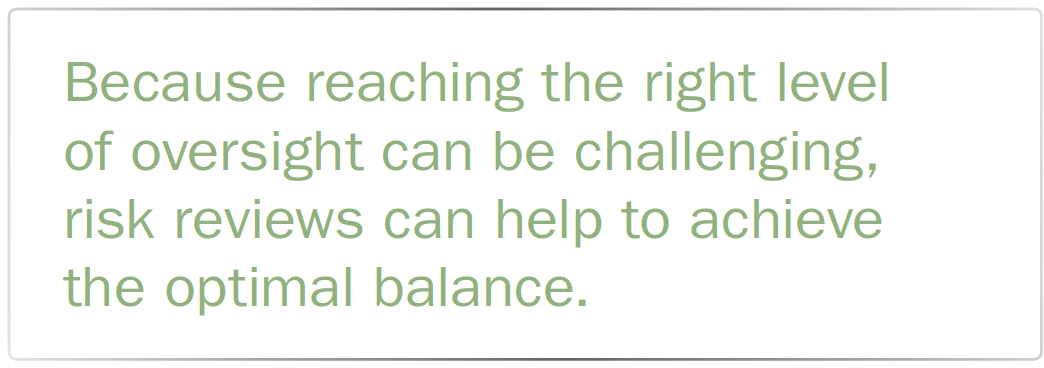
the corresponding metric taxonomy. Rather than just having a collection of metrics, you can identify the corresponding thresholds that indicate some action should occur or a risk is near realization. Effectively, these metrics are warning signs and a way of proactively mitigating the risk. One key to a successful partnership is making sure that those with shared learnings, both internal and external to the program, are preventing recurring or preventable errors.
Data-driven decisions
Knowledge of the data required to make decisions about patient safety and trial efficacy is paramount to efficiently using the vast amounts of data collected. Early in the process, identify and document the quality metrics, and more specifically, quality tolerance limits (QTLs) that need to be accessed and integrated as well as the corresponding action that must be performed.
TransCelerate has excellent resources¹ to better understand QTLs-developed as part of its risk-based monitoring initiative. Briefly, the goal of a QTL is to detect systemic risks-those that will affect the study and make it very hard to draw the right conclusions from your results.
In the initial stages of implementation, there will likely be limited availability of historical data of the systemic or random nature of observed issues. In these cases, the use of published data to define QTLs is encouraged. For new indications or compound classes, extrapolation of experiences from similar indications or trials may be appropriate. Similarly, while updating QTLs is not ideal and the number of updates to QTLs is expected to decrease to zero as experience with QTLs grows, it is understood that modifications may be required during the clinical trial. This is acceptable as long as sufficient rationale and documentation are provided in both trial documentation and the clinical study report (CSR) to justify the changes in the QTL. Also, regulators want to know that you have a documented action and will conduct root-cause analysis if something does happen.
Click to enlarge
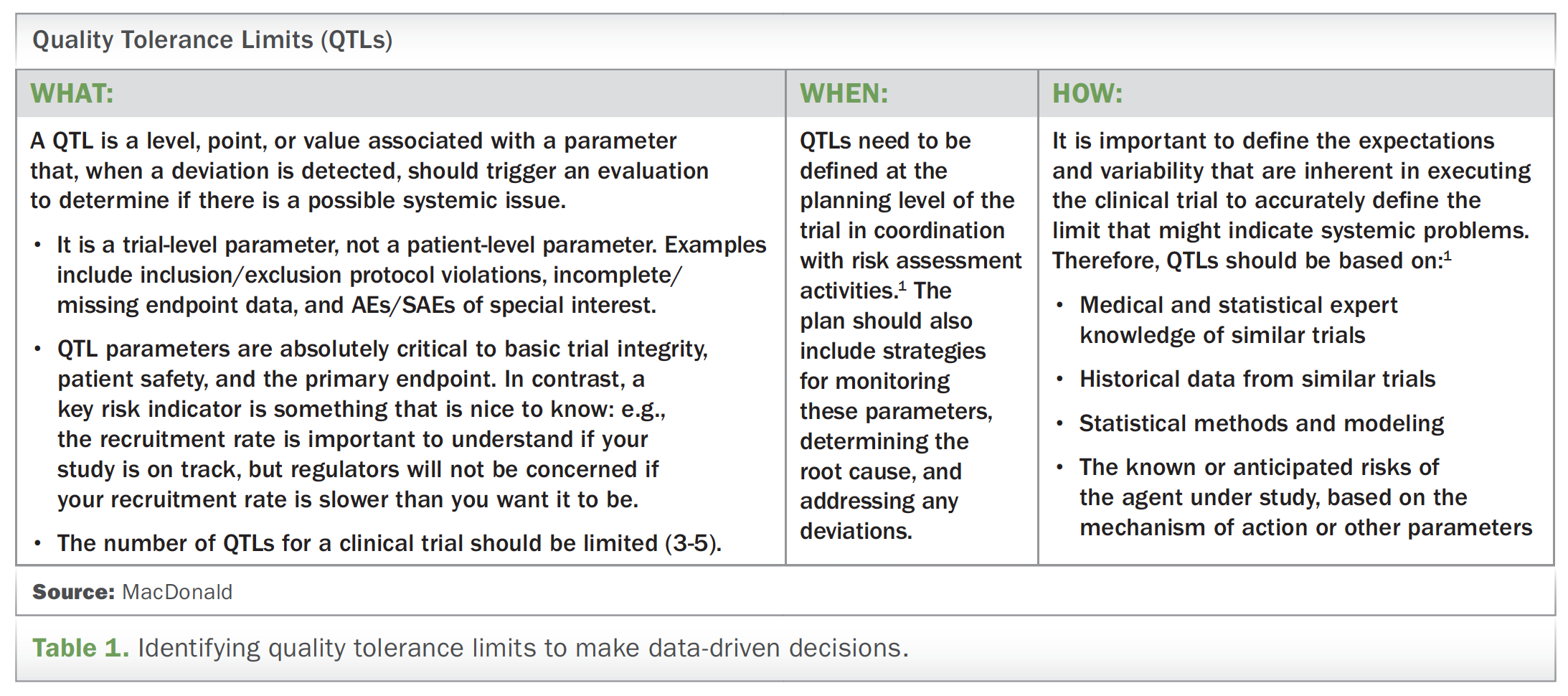
Then, ensure that you have the right technology tools available to evaluate the risk; the definition of “right” in this context means having real-time access to data and analyses, while matching the economy and efficiency to the scale of the organization and studies. Real-time decisions rely on the ability to deliver data from multiple systems in a format that’s comprehensible to humans, ideally in easy-to-use dashboards (see Figure 2 below).
For all three of these areas, the key message is one of continuous improvement and avoiding repeated issues. Perfection is not expected from the start; instead, by continuously improving practices and procedures and documenting any changes throughout the trial duration, it will be easier to comply with ICH E6 (R2).
Actionable recommendations for moving forward
A question I am frequently asked is, “How do I get my organization to move forward with implementation?”
My response: Start at the top, by obtaining commitment from the senior management team. The goal is to build an organization committed to quality, not just within the QA group. Instead of commending the project manager who stays late fighting fires, commend the project manager who escalated the risk that was about to become an issue. Then, you change the message regarding the future state of the organization.
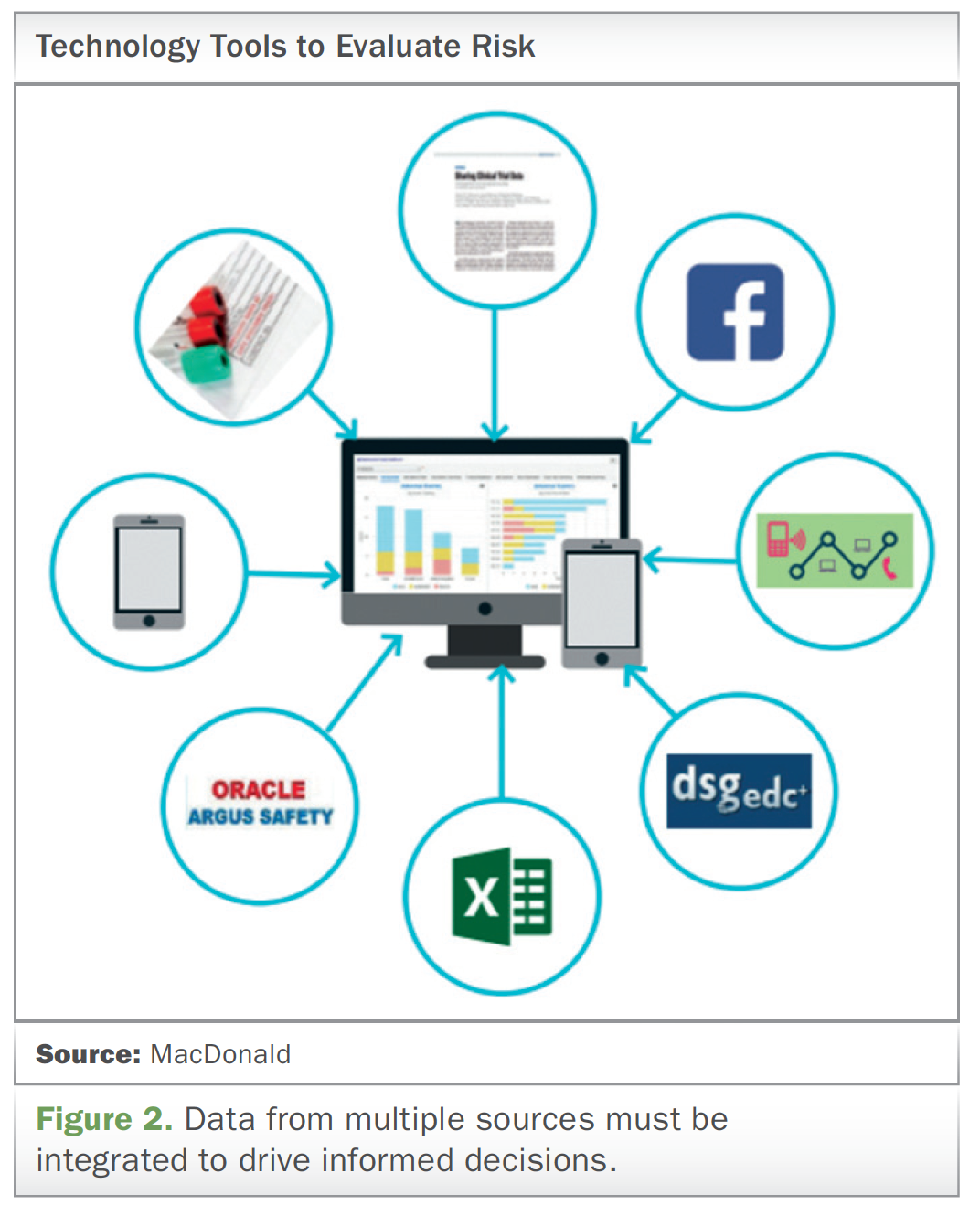
Start the risk assessment at the protocol development stage and assess the risk from the patient’s perspective as you walk through the trial. The Medicines and Healthcare products Regulatory Agency (MHRA) nine-question framework is really useful for this purpose. If your quality resources are limited, start by reviewing the current SOPs and identify where there are clear gaps from the new requirements. This can be performed internally or outsourced to a consulting group. Then, prioritize the gaps in order of importance based on the risks you are most concerned with mitigating. Once you are sure your SOPs are compliant, work on developing a right-sized holistic QMS for your organization. Electronic systems are not an absolute requirement, but ICH E6 (R2) does assume that companies can perform “real-time” assessments of risk-based on rapidly available data, metrics, and information.
See the data. We often focus on the next milestone (e.g., first patient in, all sites activated, database locked, inspection preparation), and we forget to pay attention to the indicators that might show when a problem is coming. Only collect the metrics that are actionable-move beyond the data specific to recruitment and data cleaning status to the data that are timeline-provoking. Finally, learn to implement your pre-determined action plans when the data starts to stray from the norm.
There are also tools available to help take a systematic approach to complying with ICH E6 (R2). At Avoca, we mapped tools developed in collaboration with the AQC to the 12 steps outlined in the ICH E6 (R2). These tools reduce the amount of resources needed to develop, execute, and document your QMS.
Summary
Quality remains a crucial component of clinical trials-to ensure patient safety and data integrity. Guidelines such as ICH E6 (R2) are helping to formalize and standardize quality components, while at the same time recognizing that adaptation to new knowledge is a key consideration. To get started, take a close look at your organization’s quality culture, start with your existing processes, and determine the scale of a QMS that will enable real-time monitoring and analysis but that is also suitable and manageable for your organization.
Reference
1. TransCelerate Biopharma, Inc. Risk-based quality management: quality tolerance limits and risk reporting. 2017.
Crissy MacDonald, PhD, is Executive Director, Client Delivery, The Avoca Group
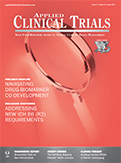
Improving Relationships and Diversifying the Site Selection Process
April 17th 2025In this episode of the Applied Clinical Trials Podcast, Liz Beatty, co-founder and chief strategy officer, Inato, discusses a number of topics around site engagement including community-based sites, the role of technology in improving site/sponsor relationships, how increased operational costs are impacting the industry, and more.
Behind the Buzz: Why Clinical Research Leaders Flock to SCOPE Summit
February 7th 2025In this episode, we meet with Micah Lieberman, Executive Conference Director for SCOPE Summit (Summit for Clinical Ops Executives) at Cambridge Innovation Institute. We will dive deep into the critical role of collaboration within the clinical research ecosystem. How do we bring together diverse stakeholders—sponsors, CROs, clinical trial tech innovators, suppliers, patients, sites, advocacy organizations, investors, and non-profits—to share best practices in trial design, program planning, innovation, and clinical operations? We’ll explore why it’s vital for thought leaders to step beyond their own organizations and learn from others, exchanging ideas that drive advancements in clinical research. Additionally, we’ll discuss the pivotal role of scientific conferences like SCOPE Summit in fostering these essential connections and collaborations, helping shape the future of clinical trials. Join us as we uncover how collective wisdom and cross-industry partnerships are transforming the landscape of clinical research.
FDA-Approved Gene Therapy Beqvez Shows Sustained Efficacy, Safety in Long-Term Hemophilia B Trial
April 17th 2025Beqvez (fidanacogene elaparvovec), an FDA-approved one-time gene therapy for hemophilia B, demonstrated sustained factor IX expression, low bleeding rates, and a favorable safety profile over long-term follow-up.